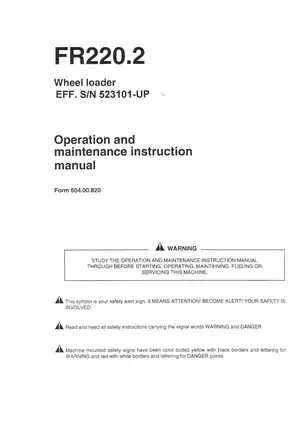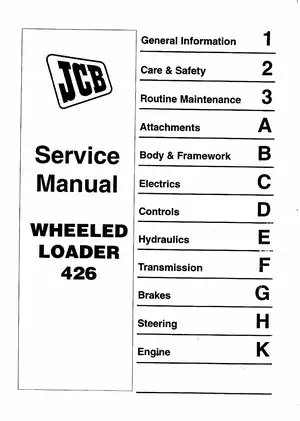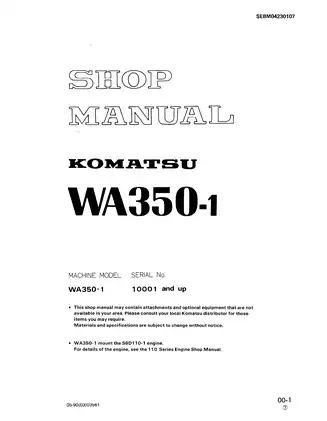Secure Your Wheel Loader Repair Manual Instantly!
Dive into our top 50 sought-after wheel loader manuals available exclusively on the [RL] marketplace.
Why are Wheel Loader Manuals Essential?
For wheel loader technicians and owners, having a detailed manual is indispensable. These manuals equip you with step-by-step guidelines to ensure precise repairs and regular maintenance, which can significantly increase the longevity of the machinery. By following these guides, owners can not only save on repair costs but also ensure the machine\'s optimum performance, enhancing overall operational efficiency.
Updates & Availability
To provide our users with the most up-to-date and pertinent manuals, we refresh this list consistently, about 1-2 times a month.
Manual Pricing
Manual pricing for wheel loaders is determined by individual sellers, not by [RL] marketplace. As a result, the same manual might vary in price. We advise checking multiple offers before making your purchase.
User Reviews
A lot of our manuals come with reviews and feedback from previous buyers, located on the detail page, to aid in your purchase decision. After your purchase, we encourage you to leave feedback, assisting future buyers in their choices.
Manual Preview
Some of our sellers offer a preview feature for their manuals. You\'re welcome to use this preview to ensure a satisfactory purchase.
Contacting the Seller
Should you wish to reach out to a manual\'s seller, please utilize our contact form at https://www.repairloader.com/contact.php. We\'ll either relay your query or address it directly on our end.
FAQ - FREQUENTLY ASKED QUESTIONS:
Is there an option to receive a physical version of the manual? : No, after your payment is processed, the manual will be immediately available for download.
Who stands as the manual\'s vendor? : [RL] marketplace isn\'t the direct vendor of the listed manuals. We just facilitate the platform and manage transactions. You can identify the specific seller on each manual\'s detailed page.
Can I trust the authenticity of the wheel loader manual? : Absolutely, [RL] only lists genuine OEM wheel loader manuals, the very same ones utilized by professional mechanics and service centers.
What file types do the wheel loader manuals come in? : The majority of the manuals can be downloaded as PDFs. Other potential formats include: zip, exe, rar, among others.
Do you have manuals covering all wheel loader models? : We have an extensive range of wheel loader manuals on [RL], and our collection is continually expanding. For specific models or brands, use the search functionality provided above.
Which categories of wheel loader manuals are available? : [RL] marketplace features a variety, including service manuals, workshop manuals, original factory manuals, repair guides, and various other informative handbooks.
Act now and get the repair manual you\'ve been searching for. This download comes with a lifetime guarantee, as detailed in our FAQs at https://www.repairloader.com/faq.php.
If our platform met your expectations, we\'d be delighted if you\'d endorse us on social platforms and become part of our Facebook community.
Wheel Loader Manuals (33 total results)
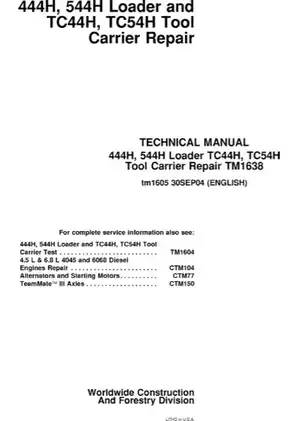
Genuine John Deere 444H, 544H Loader and TC44H, TC54H Tool Carrier - Repair, Maintenance & Troubleshooting Guide
- 444H
- 544H
- TC44H
- TC54H
- TM1605
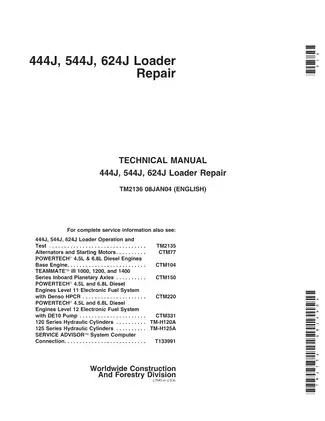
TM2136 2004 Edition: Comprehensive Loader Repair Manual: John Deere 444J, 544J, 624J (1998)
- John Deere 444J (1998)
- John Deere 544J (1998)
- John Deere 624J (1998)
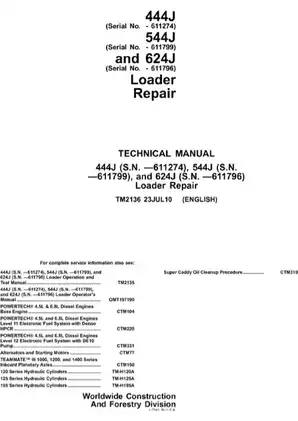
TM2136 (2010 Edition): John Deere 444J, 544J, 624J Loader - Comprehensive Repair Reference Manual
- John Deere 444J (S.N. 611274)
- John Deere 544J (S.N. 611799)
- John Deere 624J (S.N. 611796)
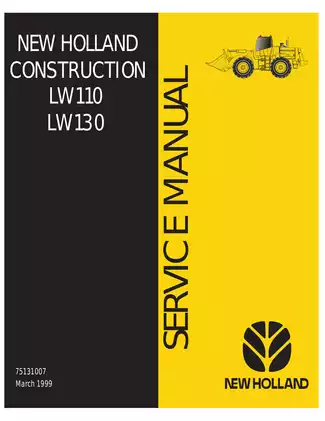
Detailed official New Holland W110, W130 Wheel Loader Service Manual
- W110 (1999)
- W130 (1999)
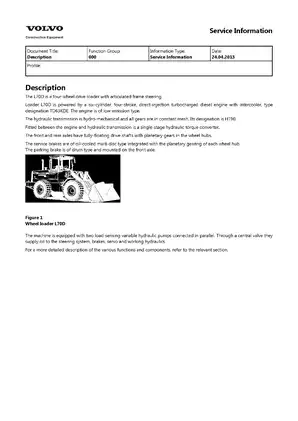
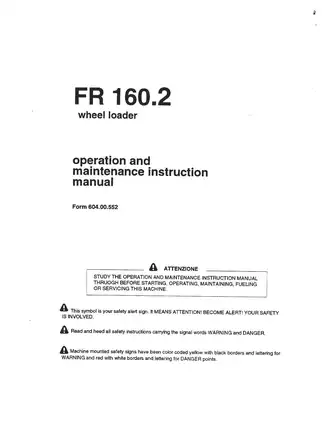
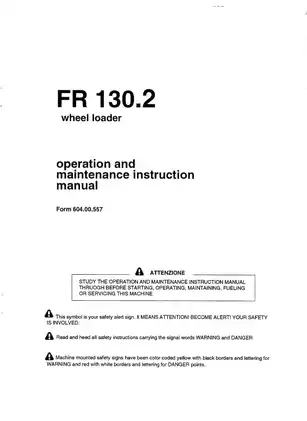
Official FiatAllis FR 130.2 Wheel Loader Operation & Maintenance Manual - Operator Safety & Service Procedures
- FiatAllis FR 130.2
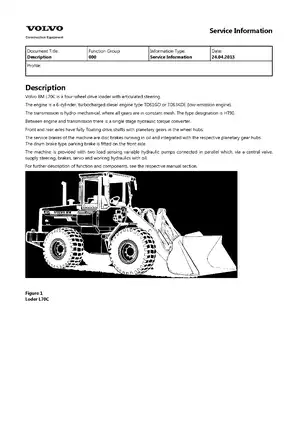
Service Manual for Volvo BM L70C Wheel Loaders
- Volvo BM L70C (2013)
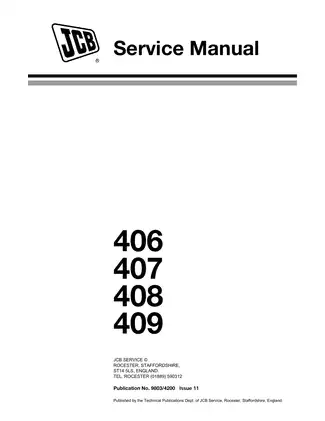
Professional-Grade JCB 406, 407, 408 & 409 Service Manual - Complete Maintenance Guide
- JCB 406
- JCB 407
- JCB 408
- JCB 409
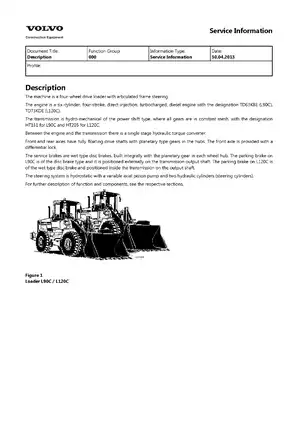
Official Complete Volvo L90C/L120C Loader 2013 - Precision Service & Maintenance Manual
- L90C (2013)
- L120C (2013)
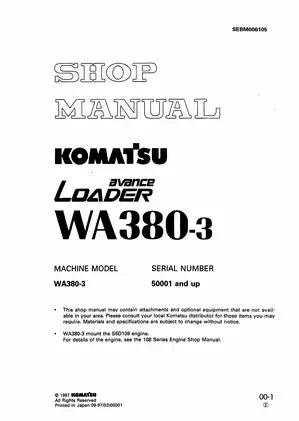
2001-2011 Komatsu WA380-3, WA 380 Avance Wheel Loader shop manual
- Komatsu WA380-3 Standard Wheel Loader - 1997-2001.
- Komatsu WA380-3 Active - 2001-2004.
- Komatsu WA380-3 Avance - 2004-2008.
- Komatsu WA380-3 MC - 2008-2011.
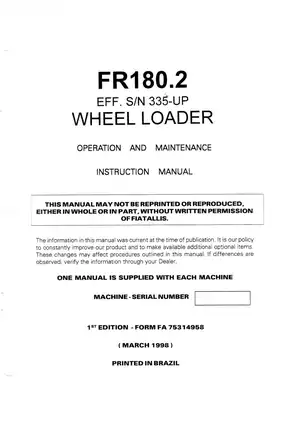
Definitive FiatAllis FR180.2 Wheel Loader Operation & Maintenance Manual, 1998 Edition
- FiatAllis FR180.2 (1998)
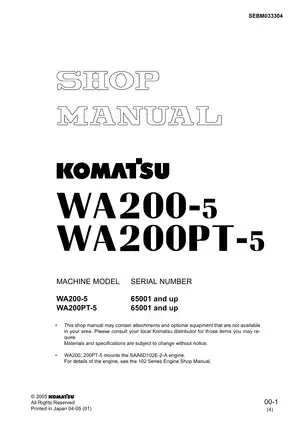
Genuine Komatsu repair manual: WA200-5, WA200PT-5, PDF
Komatsu WA200-5:
- Standard Wheel Loader variant (2004-2009)
Komatsu WA200PT-5:
- Parallel Tool Carrier variant (2005-2010)
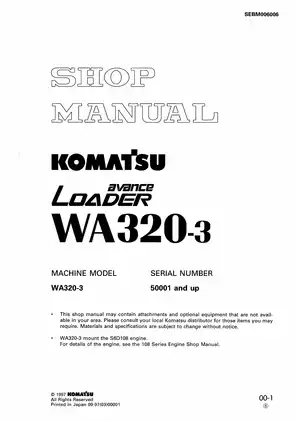
Genuine Komatsu WA320-3 repair manual
WA320-3, WA 320 / Komatsu Limited
- WA320-3, Year: 2003-2006
- WA320PZ-3, Year: 2003-2006
- WA320PT-3, Year: 2003-2006
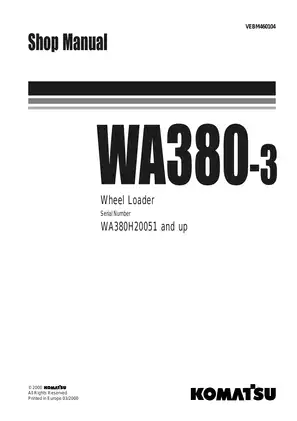
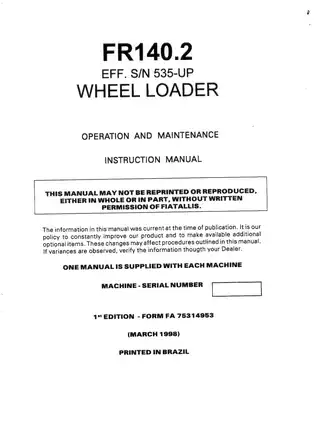
Comprehensive Operation & Maintenance Manual for Fiatallis FR140.2 Wheel Loader
- Fiatallis FR140.2 (1998)
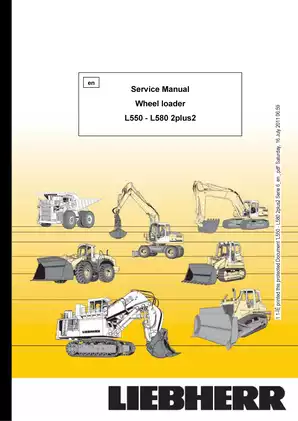
Detailed Illustrated Liebherr L550/L556/L566/L576/L580 Wheel Loader Service Manual - Factory Diagnostics & Repair Procedures
- L550 (from 16978)
- L556 (from 15653)
- L566 (from 14171)
- L576 (from 14171)
- L580 (from 14171)
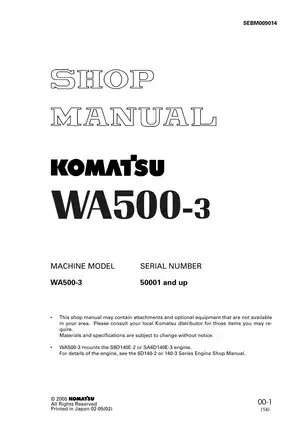
Genuine Repair Manual for Komatsu WA500-3 Wheel Loaders
WA 500 / Komatsu Limited
- WA500-3
Serial no.:
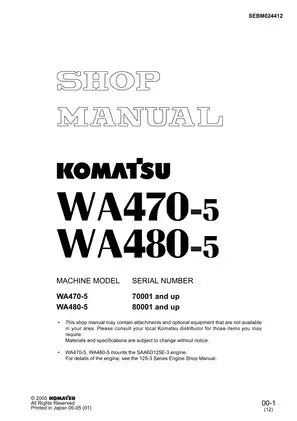
Komatsu WA470-5 and WA480-5 Loader Service Manual - Precision Maintenance & Troubleshooting Toolkit
- WA470-5 (70001 and up)
- WA480-5 (80001 and up)
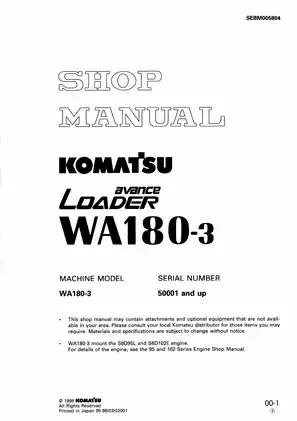
Original Comprehensive Manual for Komatsu WA180-3 Avance Loader
WA180-3, WA 180 / Komatsu Limited
- Komatsu WA180-3 (1997-2003): This foundational model set new standards in wheel loader efficiency and durability.
- Komatsu WA 180 Avance (2004-2008): Building on the legacy of the WA180-3, the Avance variant introduced enhanced features and improved performance metrics.
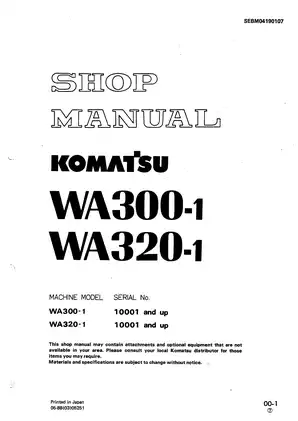
Detailed Komatsu WA300-1 and WA320-1 Repair Manual - Diagnostics and Maintenance Reference
- Komatsu WA300-1 (10001 and up)
- Komatsu WA320-1 (10001 and up)
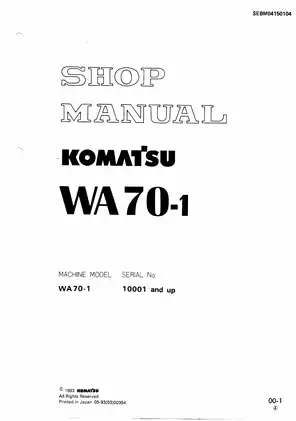
In-Depth Komatsu WA70-1 manual
Komatsu WA70-1 Wheel Loader (Base Model)
- Engine specs: 3.26 l, 41 kW, 4D95L-W, 4 cylinders, 2200 rpm, 95 x115 mm.
- Serial numbers: 10001 and up
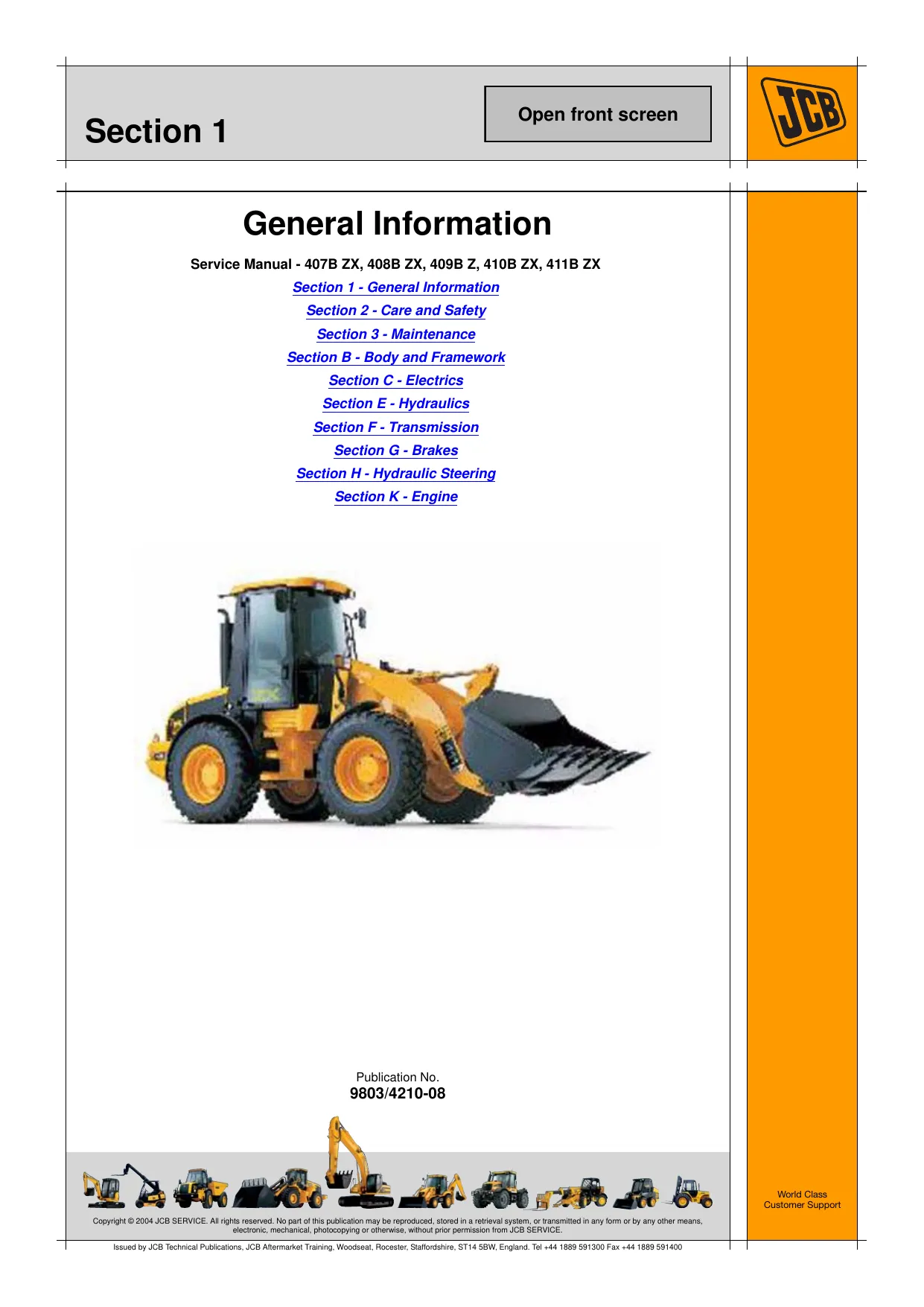
JCB 407B, 408B, 409B, 410B, 411B Wheeled Loading Shovel repair manual
- 407B
- 408B
- 409B
- 410B
- 411B / JCB
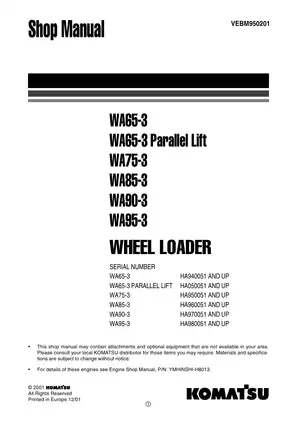
Komatsu shop manual for WA65-3, WA75-3, WA85-3, WA90-3, WA95-3 models
WA65, WA75, WA85, WA90, WA95 / Komatsu Limited
- Komatsu WA65-3 (Year Range: 2002-2007)
- Komatsu WA75-3 (Year Range: 2003-2008)
- Komatsu WA85-3 (Year Range: 2004-2009)
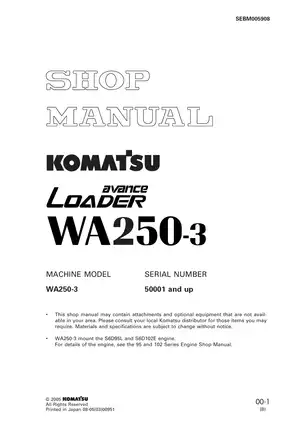
Komatsu WA250-3 Avance Loader: Definitive Repair Guide 2005+ Expert Step-by-Step
- WA250-3 (2005 and up)
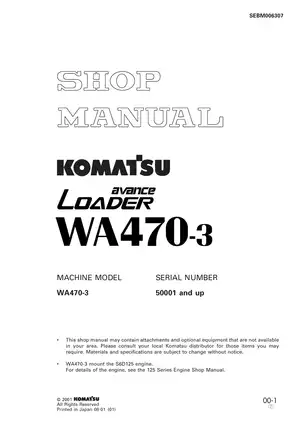
Komatsu WA470-3, WA470 Avance Wheel Loader shop manual
- WA470-3
- WA470 / Komatsu Limited
- Komatsu WA470-3
- Komatsu WA470 Avance
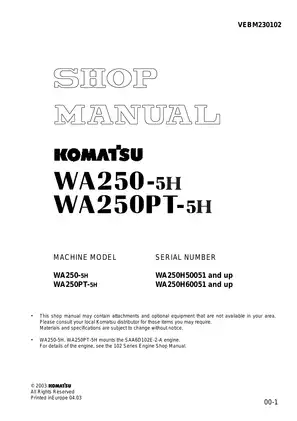
Official Komatsu WA250-5H & WA250PT-5H Diagnostic & Maintenance Manual - Operator-Level Procedures
- WA250-5H
- WA250PT-5H
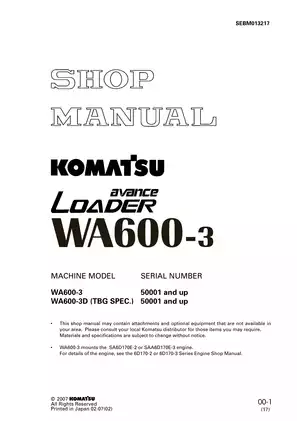
Official Komatsu WA600-3 Service & Repair Manual - Comprehensive Maintenance Guide
- WA600-3 (50001 and up)
- WA600-3D (50001 and up)
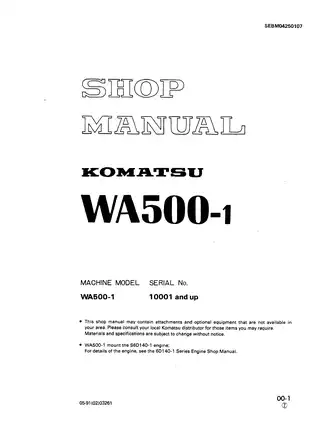
Shop-Grade Manual for detailed Komatsu WA500-1 Wheel Loaders
WA500-1 / Komatsu Limited
Serial no.: WA500-1 - 10001 and up / 20001 and up
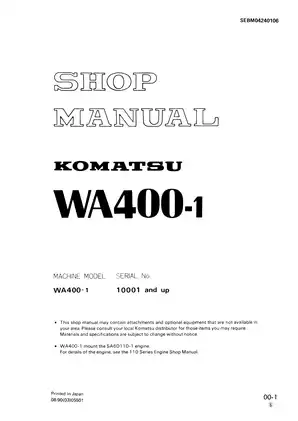
Shop-Grade Manual for Komatsu WA400-1 Wheel Loaders
WA400-1, WA400 / Komatsu Limited
- Komatsu WA400-1 - Standard (1990-1995)
- Komatsu WA400-1 - Pro (1996-1999)
- Komatsu WA400 - Premium (2000-2005)
